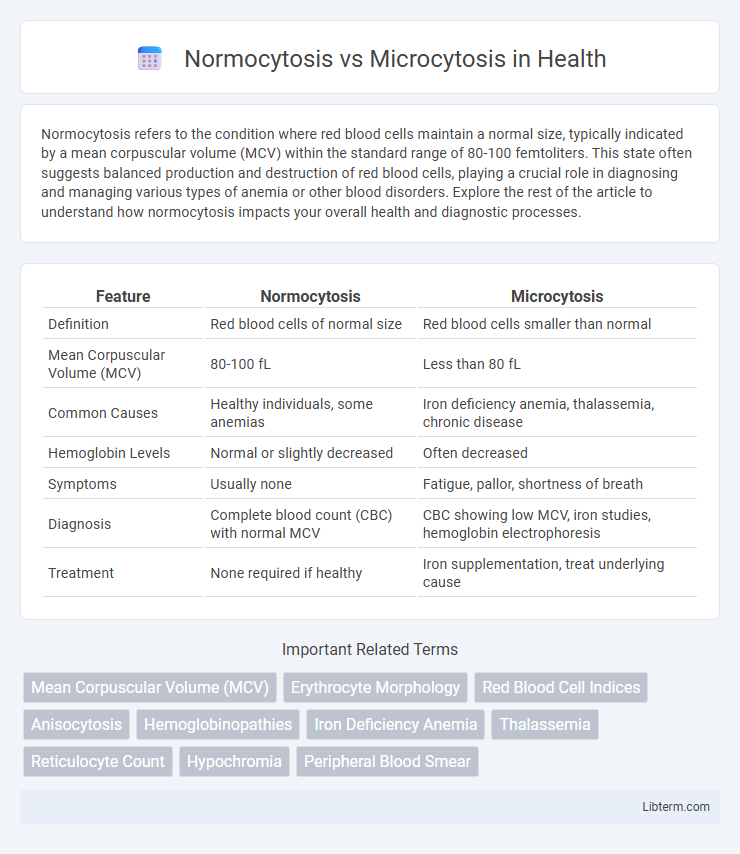Normocytosis refers to the condition where red blood cells maintain a normal size, typically indicated by a mean corpuscular volume (MCV) within the standard range of 80-100 femtoliters. This state often suggests balanced production and destruction of red blood cells, playing a crucial role in diagnosing and managing various types of anemia or other blood disorders. Explore the rest of the article to understand how normocytosis impacts your overall health and diagnostic processes.
Table of Comparison
| Feature | Normocytosis | Microcytosis |
|---|---|---|
| Definition | Red blood cells of normal size | Red blood cells smaller than normal |
| Mean Corpuscular Volume (MCV) | 80-100 fL | Less than 80 fL |
| Common Causes | Healthy individuals, some anemias | Iron deficiency anemia, thalassemia, chronic disease |
| Hemoglobin Levels | Normal or slightly decreased | Often decreased |
| Symptoms | Usually none | Fatigue, pallor, shortness of breath |
| Diagnosis | Complete blood count (CBC) with normal MCV | CBC showing low MCV, iron studies, hemoglobin electrophoresis |
| Treatment | None required if healthy | Iron supplementation, treat underlying cause |
Understanding Red Blood Cell Size: An Overview
Normocytosis refers to red blood cells (RBCs) maintaining a normal size with a mean corpuscular volume (MCV) of approximately 80-100 femtoliters, indicating proper RBC production and function. Microcytosis is characterized by smaller than normal RBCs, with an MCV below 80 femtoliters, commonly observed in conditions like iron deficiency anemia and thalassemia. Understanding RBC size helps in diagnosing the underlying causes of anemia and guides appropriate treatment strategies.
Defining Normocytosis: What Is Normal?
Normocytosis refers to the presence of red blood cells (RBCs) with a normal size and volume, typically measured by the mean corpuscular volume (MCV) ranging from 80 to 100 femtoliters. This standard cell size ensures adequate oxygen transport and reflects balanced erythropoiesis without underlying pathological conditions. In contrast, microcytosis indicates abnormally small RBCs, usually associated with conditions like iron deficiency anemia or thalassemia.
Microcytosis Explained: Smaller Red Blood Cells
Microcytosis is characterized by the presence of smaller than normal red blood cells, often measured by a reduced mean corpuscular volume (MCV) below 80 femtoliters. This condition commonly indicates disorders such as iron deficiency anemia, thalassemia, or chronic disease-related anemia, where impaired hemoglobin synthesis leads to reduced cell size. In contrast, normocytosis shows normal-sized red blood cells with an MCV between 80-100 femtoliters, reflecting stable red blood cell production and hemoglobin content.
Causes of Normocytosis
Normocytosis refers to the presence of red blood cells (RBCs) with normal volume, typically measured by mean corpuscular volume (MCV) ranging from 80-100 fL, indicating balanced erythropoiesis and iron metabolism. Causes of normocytosis include acute blood loss, hemolytic anemia, and chronic diseases where RBC production and destruction rates maintain normal cell size despite altered counts. In contrast, microcytosis is characterized by smaller than normal RBCs, commonly resulting from iron deficiency anemia, thalassemia, or chronic inflammation affecting hemoglobin synthesis.
Causes of Microcytosis
Microcytosis is primarily caused by conditions that impair hemoglobin synthesis, leading to smaller red blood cells, with iron deficiency anemia being the most common cause worldwide. Other causes include thalassemia, a genetic disorder affecting globin chain production, and chronic diseases that disrupt normal erythropoiesis. In contrast, normocytosis maintains normal red cell size despite anemia, often seen in acute blood loss or early stages of chronic disease anemia.
Key Differences Between Normocytosis and Microcytosis
Normocytosis refers to red blood cells (RBCs) having a normal size, typically with a mean corpuscular volume (MCV) between 80-100 femtoliters, while microcytosis is characterized by smaller-than-normal RBCs, with an MCV below 80 femtoliters. Normocytosis indicates balanced RBC production without size abnormalities, often seen in anemia of chronic disease, whereas microcytosis is commonly linked to iron deficiency anemia and thalassemia due to impaired hemoglobin synthesis. The distinction between normocytosis and microcytosis is critical for diagnosing underlying hematological conditions and guiding appropriate treatment strategies.
Diagnostic Approaches: Identifying Cell Size Variations
Normocytosis is diagnosed through peripheral blood smears and automated red blood cell indices, particularly mean corpuscular volume (MCV) within the normal range of 80-100 fL, indicating normal cell size. In contrast, microcytosis is identified by a decreased MCV below 80 fL, often confirmed with iron studies, hemoglobin electrophoresis, and reticulocyte counts to differentiate causes like iron deficiency anemia and thalassemia. Advanced diagnostic techniques include flow cytometry and genetic testing to precisely characterize red cell morphology and underlying pathologies.
Clinical Implications: Symptoms and Health Effects
Normocytosis, characterized by red blood cells of normal size and volume, typically indicates stable oxygen delivery and normal hemoglobin levels, resulting in minimal clinical symptoms. In contrast, microcytosis presents with smaller-than-average red blood cells, often linked to iron deficiency anemia or thalassemia, causing fatigue, pallor, and impaired tissue oxygenation. The distinct differences in cell morphology directly affect diagnostic approaches and treatment plans, as microcytosis frequently signals underlying chronic conditions requiring targeted intervention.
Treatment Strategies for Normocytosis and Microcytosis
Treatment strategies for normocytosis focus on addressing the underlying cause, often requiring supportive care such as iron supplementation in cases of anemia of chronic disease. Microcytosis treatment primarily targets iron deficiency through oral or intravenous iron therapy, alongside management of any contributing conditions like thalassemia or chronic blood loss. In both conditions, accurate diagnosis via complete blood count and iron studies guides personalized management to restore normal red blood cell indices and oxygen-carrying capacity.
Preventive Measures and Patient Management
Preventive measures for normocytosis and microcytosis center on identifying underlying causes such as nutritional deficiencies, chronic diseases, or genetic conditions through routine screenings and early blood tests. Patient management involves tailored treatment plans including iron supplementation for microcytosis due to iron deficiency anemia and monitoring red blood cell indices to maintain normal cell size in normocytosis. Regular follow-ups and lifestyle adjustments, including balanced diet and managing chronic illnesses, are essential to prevent progression and ensure optimal hematologic health.
Normocytosis Infographic

 libterm.com
libterm.com